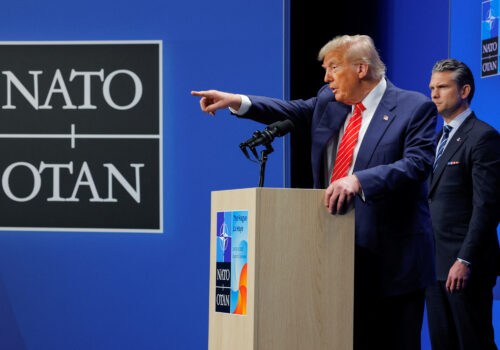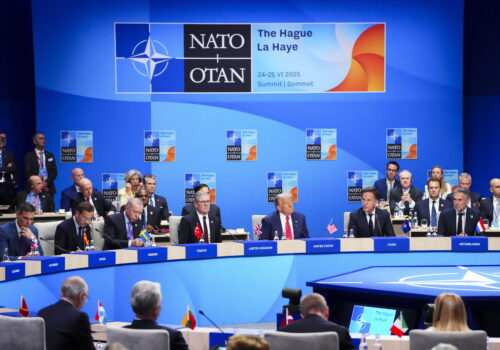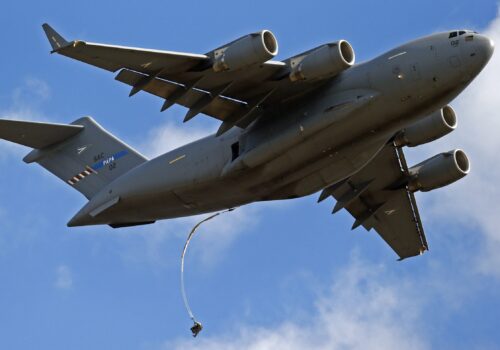A new defense spending pledge was the marquee deliverable at this year’s NATO Summit in The Hague. Yet, this “drive to five” goal—an ambition to push collective defense spending toward 5 percent of gross domestic product (GDP)—underscores a challenge that NATO leaders themselves have highlighted: the Alliance’s defense industrial capability still struggles to keep pace with its strategic ambitions.
Allies and partners now have a real opportunity to elevate defense industrial cooperation as a strategic imperative. The Hague summit made important strides, but translating commitments into real capabilities remains the decisive test. Doing so would strengthen NATO’s credibility and signal to a skeptical US administration that its calls for burden-sharing are being met with action, not just rhetoric.
A transatlantic industrial reality check
There’s no question: Increased defense spending is essential for NATO to remain fit for purpose. But without industrial output to match, scaled investments will fall short.
Russia and China continue to outpace the West across important production metrics. Western surge capability is limited. Supply chains remain fragile. And differences in national defense planning and procurement cycles continue to pose challenges for NATO’s long-term interoperability.
It will not be easy to close these gaps. Political friction, economic nationalism, and eroding trust among allies remain headwinds. Collective resolve and sustained follow-through will be critical to ensuring that NATO achieves progress.
From rhetoric to readiness
To put new defense dollars to work, NATO must treat defense industrial capacity not merely as a marketplace function, but as a core pillar of deterrence and combat power. This effort must reinforce transatlantic unity while recognizing different allies’ evolving roles, as European allies step up on the continent’s defense and the United States and Canada focus more on global strategic deterrence. Here’s how:
1. Move beyond promises to production
Momentum is building. Poland, Estonia, and other allies are boosting defense spending and industrial capacity. But industries still need more than political commitments—they need predictability. Multiyear procurement contracts, shared stockpile targets, and collaborative delivery plans are needed to send credible signals to industry. Yet many governments remain cautious about long-term contracts that could lock in funding amid shifting national priorities. Endorsed by allies at The Hague summit, NATO’s Rapid Adoption Action Plan (RAAP) is a vital step to ensure that the Alliance can match the speed of innovation and adopt technologies into its military posture in quick order. But this must be linked to specific demand signals, synchronized planning cycles, and the ability to rapidly field new technologies. The Hague summit should serve as a springboard for NATO’s Industrial Forum in the fall and related venues to solidify these mechanisms. Equally important is leveraging the strengths of small and medium-sized firms, whose innovative, cost-effective solutions can provide the scalable and attritable tech-enabled capabilities critical for modern defense. This would signal a needed shift, showing that the Alliance is committed not just to sustaining legacy platforms but investing in the future of defense production.
2. Use Ukraine as a pathfinder for innovation
Ukraine’s experience demonstrates what’s possible when necessity drives innovation. Under intense pressure, Ukrainian forces have iterated new battlefield solutions—drones, electronic warfare, counter-drone measures—in weeks rather than years. While Ukraine’s tactical gains have not always translated into strategic breakthroughs, its speed of adaptation remains instructive. NATO must capture this spirit of urgency. That means overhauling acquisition processes, streamlining contracting and approval timelines, and embracing iterative development. This isn’t just acquisition reform—it’s industrial transformation. Industry partners working in Ukraine have shown how quickly capability gaps can be addressed when missions are clear and resources are available. NATO’s innovation engines—the Defence Innovation Accelerator for the North Atlantic, known as DIANA, and the NATO Innovation Fund—must become more accepting of risk and help projects evolve from pilot programs to scalable solutions directly tied to operational needs. Language in the communiqué mirroring RAAP was a crucial first step and an implicit endorsement of the Alliance’s efforts to scale innovation. Embedding RAAP into Alliance guidance and national plans will demonstrate that NATO is serious about delivering innovation at operational speed.
3. Strengthen public-private partnerships
Governments cannot achieve this transformation alone. Industry buy-in is critical to the defense reforms envisioned under the 5 percent of GDP benchmark—split between 3.5 percent for military capabilities and 1.5 percent for innovation, security, and defense-related investments. While this structure offers flexibility, it also demands clarity. Industries must ramp up production by expanding shifts, modernizing facilities, and planning for higher volumes. Governments, meanwhile, must reduce regulatory obstacles, simplify export controls, and eliminate financial barriers that stifle smaller innovators. NATO should bring industry to the table earlier through forums such as the National Industrial Advisory Group. Trust must be earned through transparency, shared risk, and joint planning. RAAP provides a framework to accelerate technology adoption, but it must evolve into a practical mechanism for integrating private-sector partners into NATO’s strategic planning. This isn’t just about fielding new capabilities—it’s about building resilience, agility, and innovation across the transatlantic industrial base.
The cost of falling behind
NATO’s deterrence rests on more than unity—it depends on speed, readiness, and industrial credibility. The Alliance cannot afford to build an industrial base that delivers capabilities only after a crisis erupts. It must act now to ensure it can deter threats before they materialize.
Closing this gap demands urgency, pragmatism, and robust transatlantic cooperation. Investment must align with innovation. Friction must give way to flexibility. Risk must be shared. Demand signals must be clear—but remain adaptable as the security environment evolves. A system that takes a decade to deliver ground-based missiles risks irrelevance when threats emerge from space in half the time.
The Hague summit made significant progress, particularly through RAAP. But the Alliance cannot afford to let new plans become another line item in the communiqué. The test now is implementation.
If NATO can align its industrial capacity with its strategic ambition, it will remain the world’s most capable and credible military alliance. If it cannot, it risks ceding the advantage to competitors who are moving faster, scaling smarter, and shaping the future on their terms.
Let The Hague summit be remembered not just for promises—but for NATO’s tangible pivot from rhetoric to readiness.
Lieutenant General (Ret.) David J. Julazadeh is a nonresident senior fellow with the Transatlantic Security Initiative at the Atlantic Council’s Scowcroft Center for Strategy and Security. He most recently served at NATO’s Allied Command Transformation as the deputy chief of staff, capability development.
Kristen Taylor is an assistant director with the Transatlantic Security Initiative at the Atlantic Council’s Scowcroft Center for Strategy and Security.
Further reading
Thu, Jun 26, 2025
Dispatch from The Hague: It’s been Trump’s week in Europe and Iran
Inflection Points By Frederick Kempe
What connects the recent events in Iran and at the NATO Summit is that they won’t be remembered for the threats countered but rather for the opportunities seized.
Wed, Jun 25, 2025
Experts react: NATO allies agreed to a 5 percent defense spending target in a low-drama summit. Now what?
New Atlanticist By
The Alliance summit was notable for what was said and done, especially about defense spending—but also for what was left off the agenda.
Thu, Jun 5, 2025
Immediate steps that Europe can take to enhance its role in NATO defense
Issue Brief By Franklin D. Kramer, Kristen Taylor
As NATO members gather in the Hague amid uncertainty about US commitment to the continent and concerns about Russia’s military rebuilding, what can European nations do to deter and, if necessary, defeat threats from Moscow?
Image: Hellenic Army vehicles move into position after crossing the Nestos River, near Xanthi, Greece, May 30, 2025. The large-scale maneuvers in Greece brought together U.S. and NATO systems, capabilities and tactics, supporting U.S. strategic initiatives and NATO regional plans to deter, defend and dominate multi-domain environments during times of crisis and conflict. Demonstrating global deterrence and the U.S. Army’s ability to rapidly deploy U.S.-based combat power in Europe and the Arctic region alongside Allies and partners, DEFENDER 25 brings U.S. troops together with forces from 29 Allied and partner nations to build readiness through large-scale combat training from May 11-June 24, 2025. DEFENDER 25 increases the lethality of the NATO alliance through large-scale tactical training maneuvers and long-range fires, builds unit readiness in a complex joint, multinational environment and leverages host nation capabilities to increase the U.S. Army’s operational reach. During three large-scale combat training exercises—Swift Response, Immediate Response, and Saber Guardian—Ally and partner forces integrate and expand multi-domain operations capability, demonstrating combined command and control structures and readiness to respond to crisis and conflict. (U.S. Army photo by Sgt. Theodosius Santalov)




